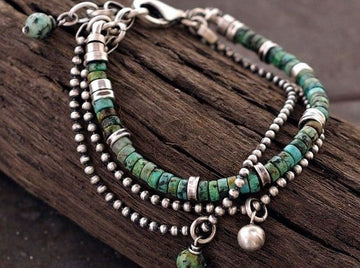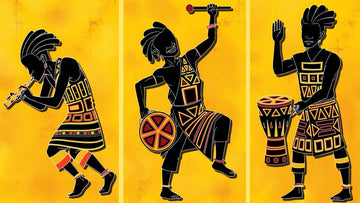The long civilization and wild nature in Africa have built up its unique legacies. The wondrous climate and geological formations endowed this land with crystals of great power-African turquoise.
African turquoise, a gemstone with a long history of jewelry, is recently regaining attention for its unique beauty and positive energy it conveys. Along with the series on 7 African Powers and African-rooted rituals and symbols, Melaninful will provide readers with knowledge about the oldest jewelry of African ancestors.
What Is African Turquoise?
Turquoise’s Origin
Turquoise is an opaque mineral that has bands of blue, cyan, green, and yellowish-green. It has been viewed as a gemstone for thousands of years. From time immemorial the ancient peoples of Africa, Asia, South America, and North America casually made turquoise one of their favorite materials for the production of gems, mosaics, and sculptures.
Turquoise is very old, from 5000 BC, and is called Callais – meaning beautiful stone. But by the 13th century, when this stone was brought to France for widespread use, it was referred to as "the stone from Turkey" and the name Turquoise began to popularize there. This is because turquoise from Iran was first shipped to Europe via this country. However, that usage is extremely common – so common that the English language uses the word “turquoise” as the name for a bluish-green color that characterizes high-quality turquoise. Very few minerals have such a famous, distinctive, and dramatic color that the name of the mineral has become as popular as turquoise.

cobalt123 from Phoenix, Arizona, USA, CC BY-SA 2.0, via Wikimedia Commons
Turquoise has been valued as a gemstone for millennia. Turquoise was used as jewelry by the ancient Egyptians and Aztecs. The mask buried in the tomb of King Tutankhamun is inlaid with turquoise stones. The Mesocericans created turquoise mosaics and the Chinese carved turquoise into the ornaments. Turquoise was also used by Native Americans in artwork and jewelry, in the belief that Turquoise imparted protective, protective properties. Tibetans have also believed in the healing properties of turquoise for centuries.
African Turquoises
Although African Turquoise is referred to as turquoise, it is not that stone in the classic definition. Instead, it is a genre of jasper produced in Africa that is frequently processed to give it the deep blue-green hue we associate with conventional turquoise. The structure of the gem, with its stunning black and brown spiders and dots, is what properly distinguishes it as a lovely replacement for the more expensive conventional type.

"Turquoise" by Kami Jo is licensed under CC BY-NC-ND 2.0
If African Turquoise isn't Turquoise at all, then what is it? Because it is a version of Jasper-a type of Chalcedony, African Turquoise, like agate and several other gemstones, is theoretically a variant of Chalcedony. In comparison to the generally translucent agate, African Jasper contains crystallized quartz, which provides it an impenetrable look.
Structure of Turquoise
The chemical formula for Turquoise is CuAl6(PO4)4(OH)8 4H2O. In nature, turquoise has a blue color that includes a range of colors that can range from green to blue. Copper gives this stone its blue color. The green color of the stone is made from iron and a little bit of chromium.
This stone also comes in other colors, often with bands of black, brown, or yellow running across this crystal. Distributed mainly in Iran, Myanmar, USA, Ethiopia, Turquoise with scientific name is Biruza / Birusa rock formed by the effect of copper with rocks containing Alumni (Feldspar) and phosphorus (apatite) under chemical conditions of geology.

Sonia Sevilla, CC0, via Wikimedia Commons
Because of the unique difference in the composition of African turquoises, this traditional African rock has a greater hardness than the conventional type (6.5 to 7 on the Mohs scale). This makes this stone a top choice for everyday bracelets or necklaces without fear of impact or breakage.
The mineral makeup of the stone, particularly crystal quartz (which gives it its wonderful organic appearance), is responsible for the stone's lovely organic appearance. The mineral makeup of the stone, which includes crystal quartz (which gives it the opaque aspect) as well as copper and iron, contributes to the stone's wonderful organic appearance.

Leon Hupperichs, CC BY-SA 3.0, via Wikimedia Commons
Because of its innate toughness, African Turquoise is an ideal choice for jewelry products designed for frequent usage at a reasonable price. Other impurities, including copper and iron, contribute to its lovely variegated color pallet.
Uses and meanings of African Turquoise
African turquoise is known as the crystal of metamorphosis since it brings about significant change and transition in one's life. This lovely stone changes your perspective to the potential of new and undiscovered experiences. It enables us to acknowledge necessity development and provides us the courage to embrace it confidently.
Self-evolution Effects
The "Stone of Evolution" is African Turquoise. Metaphysically, this evolutionary stone is meant to assist you in making essential changes in your life and to open you up to what the future has for you. It also promotes growth and development to promote good transformation from within. It broadens one's mind to fresh ideas and limitless possibilities.
African Turquoise is a stone that encourages structure and harmony, allowing one to awaken to their true purpose. It assists you in balancing your past and future as you continue to develop into your genuine self. It encourages people to apply the information they already have while also exposing them to the wisdom of others to help them become better people for the benefit of all of mankind.

Metropolitan Museum of Art , CC0, via Wikimedia Commons
African Turquoise, on the other hand, is said to help with mood swings, acceptance, and soothing sensations of emotional irritation, resulting in a more hopeful outlook on life. It is a Third Eye Chakra stone, which opens your eyes and mind to fresh thoughts and your actual purpose. Carry it with you, and you'll feel reassured while you explore new possibilities.
Because African Turquoise resonates with the Third Eye Chakra, it helps the wearer gain deeper insight. The stone wakes our spiritual bodies to their fullest purpose, giving information from the past to help us through times of transition and progress. It opens the door to a clear, concentrated mind. African Turquoise will assist those seeking guidance to their highest inner self, as it is a critical tool in the job of widening and strengthening all areas as we mature.
Health Effects
Turquoise has a long history of being used as an amulet in many cultures. In many places, wearing Turquoise is believed to ward off unexpected calamities and protect them from evil spirits while in others it is believed to simply bring good luck and prolong life. In some cultures, turquoise is believed to have a direct link to the health of the wearer. Turquoise will be pale, dark when the owner is sick or sick, and become brighter when the owner is healthy again.
African Turquoise stone brings many health benefits to humans. It is said to relieve migraines and benefit the brain, eyes, ears, neck, lungs, and throat. In Hinduism, turquoise is associated with the throat chakra and the 3rd eye chakra. Therefore, Turquoise affects the pineal gland, thyroid gland, and ovary gland, helping to enhance the immune system in humans. Throat problems can be relieved by taking Turquoise.
Turquoise's energy helps to balance negative energy and electromagnetic radiation in the air, which is very beneficial to human health in today's modern life.
Healing Effects
Turquoise is a crystal of balance so it can help you to alleviate anxiety and cure neurasthenia. In addition, it helps prevent panic attacks, gives strength, prevents panic attacks as well as destructive behaviors, treats trauma, and releases fear.
Turquoise is also very good for anorexia, headaches, and immune problems. In particular, this stone can help cure problems related to eyes, throat, lungs, asthma, infections, inflammation and helps to regenerate muscles, reduce acid levels in the body, and improve blood and system. endocrine, and neurological.
Psychic Effects
Turquoise is the stone of sincerity. This stone can help you to be mentally strong and have a sense of security in life. Therefore, this stone will be very useful for those who are shy and want to give up their shyness.
In addition, turquoise helps the wearer attract money, love, health, and beauty. This stone is also known as the stone of good luck. Many civilizations around the world have considered Turquoise as a bridge between Heaven and Earth, so they believe that wearing turquoise will help increase self-knowledge and insight.
Besides, the power that turquoise emits will increase when combined with silver. Turquoise absorbs all forms of negative energy and helps the wearer develop their inherent potential.
When wearing turquoise, it will protect you from bad energies. This stone also helps the wearer stay awake when doing spiritual actions. Turquoise has very good healing effects both mentally and physically and strengthens the body.
Precautions When Using African Turquoise
Because the composition of turquoise contains copper, phosphorus and is hydrated, this stone is very susceptible to temperature and chemical effects. The turquoise stone is relatively soft, so if not cared for, the stone can change color to pale.
Therefore, to keep the stone from discoloring, it is necessary to protect the stone when wearing it to avoid exposure to cosmetics, heat, and strong light. Its natural structure makes it very easy to lose water at slightly high temperatures. Dehydration will detract from the beauty of turquoise as they can be discolored.
When wearing jewelry made from turquoise, you should avoid letting it get too hot or get chemicals. Note that your sweat can also be acidic, so it will tarnish the turquoise. When turquoise is discolored it is most likely their sign that it needs to be "washed". Turquoise is very fond of copper, so one can “recharge turquoise next to copper or white quartz. Note that turquoise should not be exposed to the sun.
--------------------
We always want good things to come to our lives and those we love. African turquoise, a stone of positive ancient energy, would make a great Christmas gift for your beloveds. Makeup yourself and around with the divine energy of African turquoise. Stay believe, stay holy!













